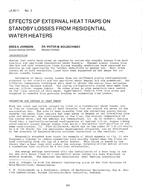-
-
Available Formats
- Options
- Availability
- Priced From ( in USD )
-
Available Formats
-
- Immediate download
- $16.00
- Add to Cart
Customers Who Bought This Also Bought
-

LA-80-11-2 -- Effects of External Heat Traps on Standby L...
Priced From $16.00 -

LA-80-05-2 -- Using the Heat Pump Annual Utilization Effi...
Priced From $16.00 -

LA-80-13-5 -- The Consumption of Energy and of Capital in...
Priced From $16.00 -

LA-80-13-2 -- Use of Liquid Sorption Dehumidification to ...
Priced From $16.00
About This Item
Full Description
Five studies are reviewed which address the psychology of thermal comfort. They are summarized as follows: (1) under identical temperature conditions, adding wood panels to the walls, carpet, and comfortable furniture made people feel warmer than when they were in the stark, sterile setting of the room before it was modified; (2) at 65°F (18.3°C), secretaries who were informed that a radiant heater was operating in the modesty panel of their desks, felt warmer than those who were not informed-that it was operating; (3) when people were told that the temperature of a room was 74°F (23.3°C) when it actually was 72°F (22.2°C), 70°F (21.1°C), or 68°F (20°C), they were just as comfortable as when the room temperature was 74°F (23.3°C); (4) in a study to determine if comfort was related to the season of the year, it was found that cool temperatures are preferred over warm temperatures in the summer and the opposite is true in the winter; (5) based on a questionnaire in which temperatures were ranked as cooler-than-comfortable, comfortable, and warmer-than-comfortable, a Preferred Comfort Envelope was proposed that ranges from 70°F (21.1°C) to 76°F (24.4°C).





